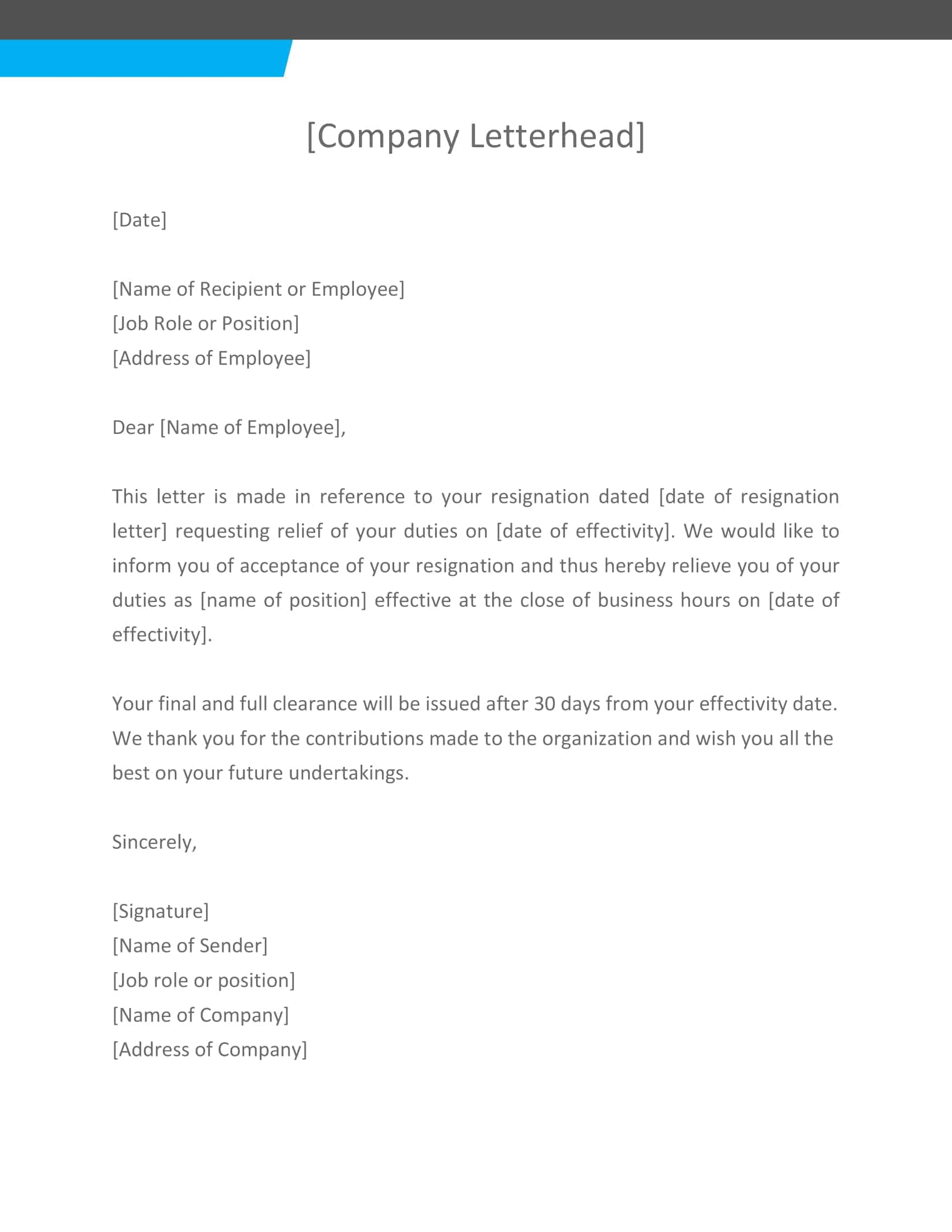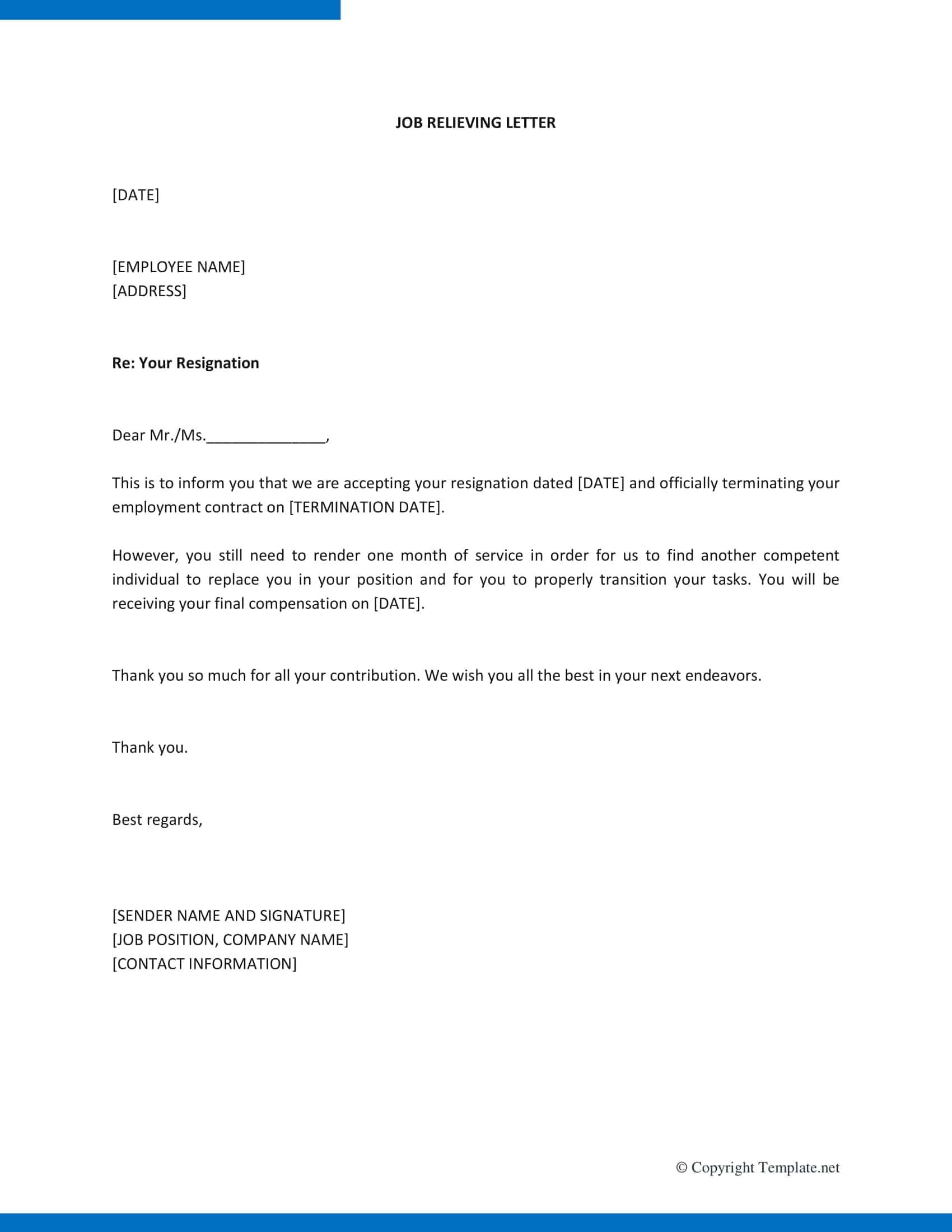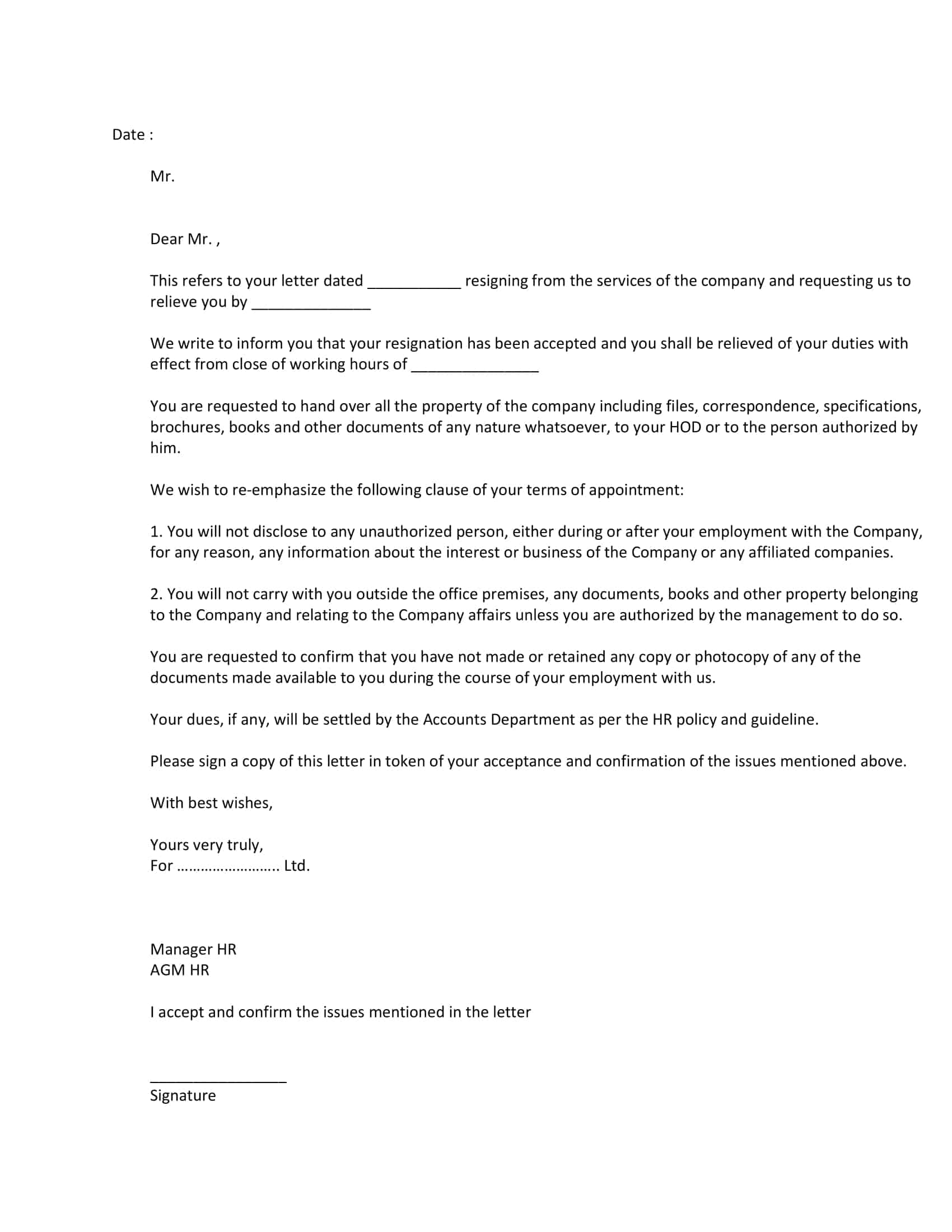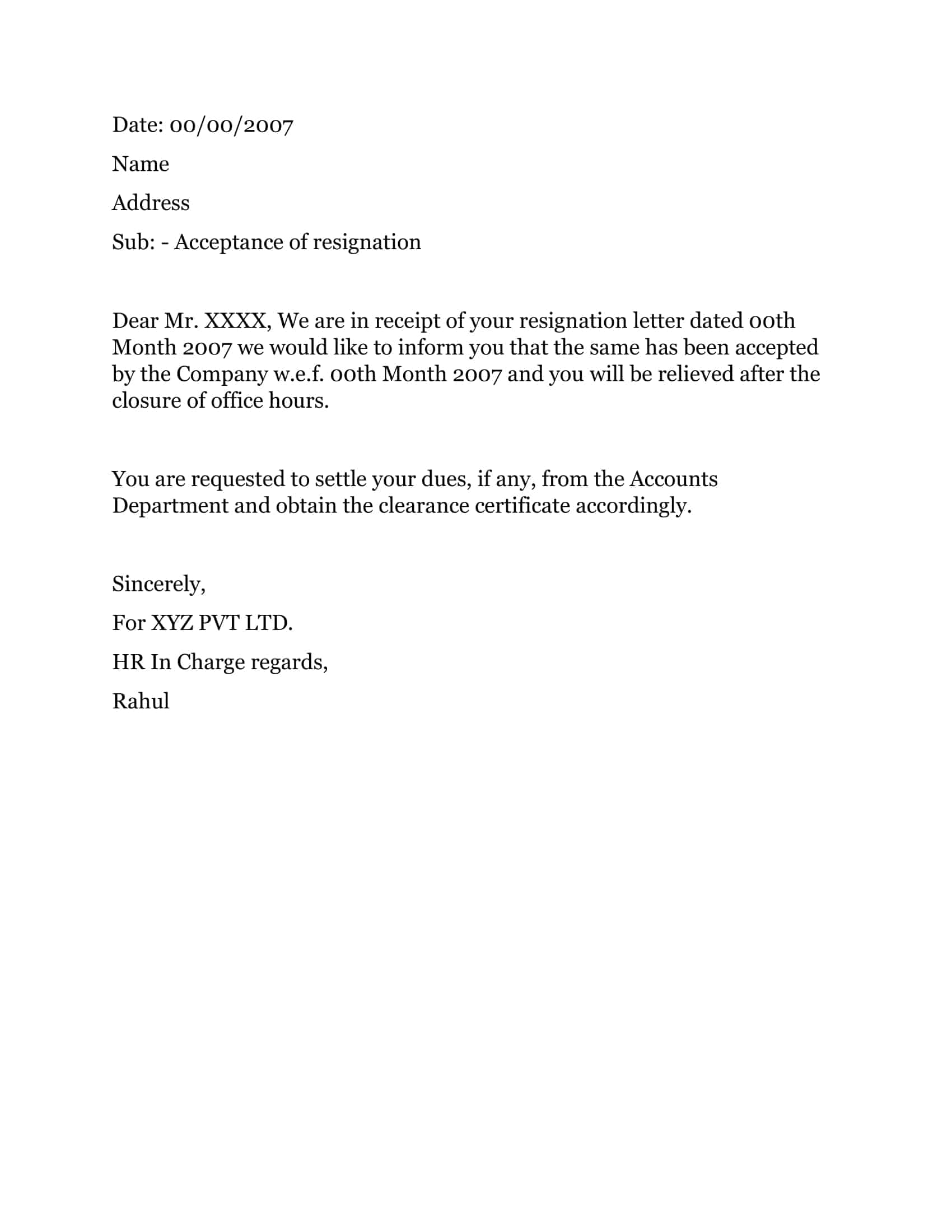A relieving letter is an official document that is provided by an employer to an employee upon their resignation or termination. It serves as proof that the employee has formally resigned from the company and that their employment has been terminated.
The letter, which is written on the company’s letterhead, contains details about the employee’s last working day, their job title, and any other relevant information. In this article, we will discuss the importance of a relieving letter, the information it should contain, how to request one, and how to use it in future job applications.
Table of Contents
Learn Why Relieving Letter is Important

A relieving letter is an essential document for both the employer and the employee, as it serves as proof of the employee’s separation from the company. It is a legal document that confirms the employee’s last working day and their job title, and it is often required when an employee applies for a new job or for any other official purpose.
For employees, a relieving letter is important because it serves as proof that they have formally resigned from their previous employer and that their employment has been terminated. It is often required as a part of the joining formalities for a new job, and without it, the employee may face difficulties in joining their new employer.
For employers, a relieving letter is important because it serves as proof that the employee has formally resigned and that their employment has been terminated. It also helps to protect the employer from any potential legal issues that may arise in the future.
Additionally, a relieving letter also serves as an official record of the employee’s job tenure and job title. This information is important for the employee’s future job applications and for the employer’s records. It also ensures that the employee receives their final settlement and any other benefits they are entitled to.
Overall, a relieving letter is a crucial document that helps to formally end the employment relationship between an employer and an employee, and it is essential for both parties to have a copy of it for their records.
Relieving Letter Templates
Transition smoothly from one professional endeavor to another with our comprehensive collection of Relieving Letter Templates. These free, printable templates provide a formal and official document to confirm the end of an employee’s tenure with a company or organization. A relieving letter serves as proof of employment termination and includes important details such as the employee’s last working day, job title, and any outstanding dues or benefits.
Our Relieving Letter Templates are customizable, allowing you to personalize the content according to your specific requirements. By utilizing our templates, you can ensure a smooth departure for employees and maintain a positive relationship as they move on to new opportunities. Streamline your HR processes and provide employees with a professional and comprehensive relieving letter. Download our templates now and facilitate smooth employee transitions with ease.
Elements of a Relieving Letter
A relieving letter should include the following information:
The employee’s full name and job title: The letter should clearly identify the employee by name and state their job title at the time of their resignation or termination.
Date of resignation or termination: The letter should state the employee’s last working day, including the date and the month.
Reason for resignation or termination: The letter should state whether the employee resigned or was terminated, and if applicable, the reason for their resignation or termination.
Acknowledgement of final settlement: The letter should acknowledge that the employee has received their final settlement, including any outstanding salary, bonuses, or other benefits they are entitled to.
Acknowledgement of return of company property: The letter should acknowledge that the employee has returned all company property, such as keys, equipment, and confidential documents, to the employer.
Wishes for future: The letter should express the employer’s best wishes for the employee’s future endeavors.
Signature of the employer: The letter should be signed by the employer or a authorized representative of the company.
Company’s letterhead: The letter should be written on the company’s letterhead and include the company’s name, address, and contact information.
It is key point to note that the above information may vary depending on the company’s policy or local laws. It is recommended to consult with a legal professional to ensure that the letter complies with all relevant laws and regulations.
When should you receive a relieving letter?
An employee should receive a relieving letter upon their resignation or termination from a company. The letter serves as proof of the employee’s separation from the company, and it should be provided by the employer on the employee’s last working day or as soon as possible thereafter.
In the case of resignation, the employee should request the relieving letter from their employer and should receive it upon the completion of their notice period or on their last working day, whichever is earlier.
In the case of termination, the employer should provide the relieving letter to the employee on the day of their termination or as soon as possible thereafter.
It is crucial to note that the timing of when a relieving letter is provided may vary depending on the company’s policy or local laws. It is recommended to consult with a legal professional to ensure that the letter is provided in a timely manner and complies with all relevant laws and regulations.
Essential Points To Consider While Writing Relieving Letter
When writing a relieving letter, there are several key points to consider:
Compliance with company policy and local laws: Before writing the letter, ensure that it complies with the company’s policy and local laws.
Clarity and precision: The letter should be written in a clear and precise manner, avoiding any ambiguity or confusion.
Identification of the employee: The letter should clearly identify the employee by their full name and job title.
Date of resignation or termination: The letter should state the employee’s last working day, including the date and the month.
Reason for resignation or termination: The letter should state whether the employee resigned or was terminated, and if applicable, the reason for their resignation or termination.
Acknowledgement of final settlement: The letter should acknowledge that the employee has received their final settlement, including any outstanding salary, bonuses, or other benefits they are entitled to.
Acknowledgement of return of company property: The letter should acknowledge that the employee has returned all company property, such as keys, equipment, and confidential documents, to the employer.
Wishes for future: The letter should express the employer’s best wishes for the employee’s future endeavors.
Signature of the employer: The letter should be signed by the employer or a authorized representative of the company.
Company’s letterhead: The letter should be written on the company’s letterhead and include the company’s name, address, and contact information.
How to Write A Request For Relieving Letter
Writing a request for a relieving letter is a formal process that requires careful consideration of the language and tone used. Here is a step-by-step guide on how to write a request for a relieving letter:
Step 1: Prepare a Draft
Before you start writing your request, it’s important to have a clear understanding of the information that should be included. It’s helpful to prepare a draft of the letter that includes the following information:
- Your full name and job title
- The date of your resignation or termination
- The reason for your resignation or termination
- Your last working day
Step 2: Use a Professional Tone
A request for a relieving letter is a formal document, so it’s important to use a professional tone. Avoid using casual or informal language and ensure that the letter is written in a clear and concise manner.
Step 3: Address the Letter to the Right Person
Make sure to address the letter to the appropriate person in your organization. This could be your immediate manager, HR representative or the management team.
Step 4: State Your Request Clearly
In the first sentence of the letter, state your request for a relieving letter clearly and without ambiguity. For example, “I am writing to request a relieving letter as I have resigned from my position as (Your Position) effective (Your last working day)”.
Step 5: Provide the Reason for Resignation or Termination
If you are resigning, provide the reason for your resignation. If you have been terminated, state the reason why, if you are aware of it.
Step 6: Provide Your Last Working Day
Inform the management of your last working day and ask them to provide the relieving letter on or before the said date.
Step 7: Acknowledge Outstanding Payment
If you have any outstanding payment, inform the management in your letter.
Step 8: Acknowledge Return of Company Property
Inform the management in your letter that you have returned all company property such as keys, equipment, and confidential documents to the employer.
Step 9: Express Your Gratitude
Express your gratitude for the opportunity to work with the company and your colleagues.
Step 10: Include Your Signature
Include your signature at the bottom of the letter and provide your contact information in case they need to reach you.
Step 11: Send the Letter
Send the letter to the appropriate person via email or mail.
It’s important to note that the above guide is a general template and may need to be adjusted depending on the specific circumstances and company’s policy. It is recommended to consult with a legal professional to ensure that the letter complies with all relevant laws and regulations.
Additional Tips:
- Always keep a copy of the letter for your records
- Proofread your letter for spelling and grammar errors
- Be polite and professional in your request.
- Keep in mind that the relieving letter is a legal document and should be treated as such.
- Be sure to submit the letter in a timely manner so that you can receive the relieving letter before your last working day.
Sample Of Request For Relieving Letter
[Your Name]
[Your Address]
[City, State ZIP Code]
[Email Address]
[Phone Number]
[Date]
[Employer’s Name]
[Company Name]
[Company Address]
[City, State ZIP Code]
Dear [Employer’s Name],
I am writing to request a relieving letter as I have resigned from my position as [Your Position] effective [Your last working day]. I have enjoyed working with the company and appreciate the opportunities that have been provided to me.
My last working day will be [Your last working day]. I would appreciate it if you could provide me with the relieving letter on or before that date.
I would like to inform you that I have returned all company property such as keys, equipment, and confidential documents to the employer. Also, I would like to inform you that I do not have any outstanding payment to be settled.
Thank you for your understanding and support throughout my tenure at [Company Name]. I wish the company continued success in the future.
Please let me know if you require any further information or clarification.
Sincerely,
[Your Signature]
[Your Name]
FAQs
Can an employee request a relieving letter?
Yes, an employee can request a relieving letter from their employer. They should make the request in writing and include their last working day, their contact information, and the contact information of the company.
What should an employee do if they do not receive a relieving letter?
If an employee does not receive a relieving letter, they should contact their employer and request one. If the employer is unresponsive or unwilling to provide a relieving letter, the employee should seek legal advice.
How long does it take to get a relieving letter?
It can take anywhere from a few days to a few weeks to receive a relieving letter, depending on the company’s policies and procedures.
How do you write a relieving letter?
To write a relieving letter, start by including the employee’s name, position, and dates they were employed. State that the employee is relieved from their duties and responsibilities effective the last date of employment. Thank them for their services and wish them the best in future endeavors.
How do I write a relieving letter to an employee?
When writing a relieving letter to an employee, address them directly using “Dear [name]”. Open with confirming their last day of employment and that they are relieved from duties effective that date. Express appreciation for their work and contributions. Close by wishing them success and providing instructions like returning company property. Sign off with regards.
Is relieving letter mandatory in USA?
No, a relieving letter is not mandatory in the USA. They are sometimes provided as a courtesy to the employee upon request. However, there is no legal requirement for companies to provide relieving letters for exiting employees in the United States.
What is the purpose of a relieving letter?
The main purpose of a relieving letter is to formally confirm that the employee has been relieved of their duties and is no longer working for the company. It certifies their employment dates and position.
What information should be included in a relieving letter?
A relieving letter should include the employee’s full name, position title, date of joining, last working date, and a statement that the employee is relieved from the organization. The letterhead, signature, and contact details should also be included.
Should the reason for leaving be mentioned in a relieving letter?
No, the relieving letter should not mention the reason for the employee leaving the company. It should simply confirm their employment details and state they have been relieved of their duties. The reason for leaving is considered private and does not need to be specified.





































![Free Printable Friendly Letter Templates [PDF, Word, Excel] 1st, 2nd, 4th Grade 1 Friendly Letter](https://www.typecalendar.com/wp-content/uploads/2023/05/Friendly-Letter-150x150.jpg 150w, https://www.typecalendar.com/wp-content/uploads/2023/05/Friendly-Letter-1200x1200.jpg 1200w)
![Free Printable Employee Recognition Letter Templates [PDF] Hard Work 2 Employee Recognition Letter](https://www.typecalendar.com/wp-content/uploads/2023/03/Employee-Recognition-Letter-150x150.jpg 150w, https://www.typecalendar.com/wp-content/uploads/2023/03/Employee-Recognition-Letter-1200x1200.jpg 1200w)
![61+ Free Printable Letter of Reprimand Templates [Word] Example 3 Letters of Reprimand](https://www.typecalendar.com/wp-content/uploads/2023/04/Letters-of-Reprimand-150x150.jpg 150w, https://www.typecalendar.com/wp-content/uploads/2023/04/Letters-of-Reprimand-1200x1200.jpg 1200w)
